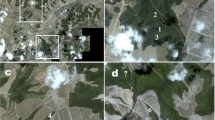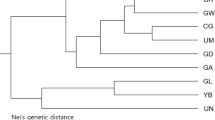Abstract—
The adaptation of different Spiraea species to changing environmental conditions is associated with typical biomorphological and reproductive strategies. Forest species of the Spiraea genus form clonal–panmictic populations and have strategies combining the advantages of panmictic and clonal populations. The populations of these species are genetically stable due to a combination of different forms of renewal and the ability to change adaptive strategies. The levels of genetic variability in the populations of forest Spiraea species can vary widely. Steppe and rocky species of Spiraea form mainly panmictic populations, in which cross pollination prevails and monocentric biomorphs are observed. Closely related crossings occurring both inside one clone and between clones cause low levels of variability. The Spiraea species from moist habitats mainly form clonal populations with polycentric biomorphs and vegetative propagation due to root offshoots and/or xylorhizomes, with low levels of variability due to the formation of identical clones or average variability due to mutations. The results of genetic studies of the Spiraea species can be used to identify populations requiring preservation, as well as to manage genetic resources ex situ.




Similar content being viewed by others
REFERENCES
Altukhov, Yu.P., Geneticheskie protsessy v populyatsiyakh (Genetic Processes in Populations) Moscow: Akademkniga, 2003.
Anders, C.M. and Murrell, Z.E., Morphological, molecular, and biogeographical variation within the Imperiled Virginia Spiraea, Castanea, 2001, vol. 66, nos. 1–2, pp. 24–41.
Belikovich, A.V. and Galanin, A.V., Transbaikal kharganat as a type of vegetation, Komarovskie Chteniya, 2006, no. LII, pp. 98–126.
Bitse, M., Species and hybrids of Meadowsweet (Spiraea L.) of the section Spiraria Ser., cultivated in the Latvian SSR, in Botanicheskie sady Pribaltiki. Okhrana rastenii (Baltic Botanical Gardens. Plant Protection), Riga: Zinatne, 1977, pp. 197–208.
Bondarevich, E.A. and Popova, O.A., Features of phytocoenoses involving the Melica virgata Turcz. ex Trin. (Poaceae) of East Transbaikalia in comparison with the neighboring territories, Turczaninowia, 2014 vol. 17, no.4, pp. 97–109. https://doi.org/10.14258/turczaninowia.17.4.16
Brzyski, J.R., Isolation and characterization of microsatellite markers in the rare clonal plant, Spiraea virginiana (Rosaceae), Am. J. Bot., 2010, pp. e20–e22. https://doi.org/10.3732/ajb.1000008
Brzysky, J.R., Genetic variation and clonal structure of the rare, riparian shrub Spiraea virginiana (Rosaceae), Conservation Genet., 2011, vol. 12, pp. 1323–1332.
Brzysky, J.R. and Culley, Th.M., Seed germination in the riparian zone: the case of the rare schrub, Spiraea virginiana (Rosaceae), Castanea, 2013, vol. 78, no. 2, pp. 87–94.
Choi, H.J., Eom, H.S., Choi, M.J., et al., Taxonomic review of Spiraea chartacea compared with its related species of section Chamaedryon in Korea, Journal of Asia-Pacific Biodiversity, 2019, vol. 12, pp. 631–642. https://doi.org/10.1016/j.japb.2019.08.008
Emery, K., Effects of open pollination, selfing, inbreeding, and outbreeding on seed set and variability in Spiraea virginiana Britton (Rosaceae), J. Undergrad. Res. Univ. of North Carolina, 2014, pp. 400–409.
Fadeeva, T.S., Sosnikhina, S.P., and Irkaeva, N.M., Sravnitel’naya genetika rastenii (Comparative Plant Genetics), Leningrad: Leningr. Univ., 1980.
Galanin, A.V. and Belikovich A.V. Dauria as a subregion of the Dauro-Manchurian botanical-geographical region, Komarovskie Chteniya, 2006, no. LIII, pp. 9–31.
Gitzendanner, M.A. and Soltis, P.S., Patterns of genetic variation in rare and widespread congeners, Am. J. Bot., 2000, vol. 87, pp. 783–792.
Grant, V., Plant Speciation, New York: Columbia University Press, 1981.
Hall, I.V., Murray, R.A., and Jackson, L.P., The biology of Canadian weeds. 2. Spiraea latifolia, Can. J. Plant Sci., 1974, vol. 54, pp. 141–147.
Hedrick, P.W., Maintenance of genetic polymorphism: spatial selection and self-fertilization, The American Naturalist, 1998, vol. 152, pp. 145–150.
Herben, T., Suda, J., and Klimešová, J., Polyploid species rely on vegetative reproduction more than diploids: a re-examination of the old hypothesis, Ann. Bot., 2017, vol. 120, pp. 341–349.
Huh, M.K., Genetic diversity and population structure of Spiraea prunifolia for. simpliciflora by inter-simple sequence repeats, J. Life Sci., 2009, vol. 19, no. 9, pp. 1183–1189.
Imetkhenova, O.V., Features of the distribution of Spiraea aquilegifolia Pallas in the Selenga middle mountains: Western Transbaikalia, Cand. Sci. (Biol.) Dissertation, Ulan-Ude: Buryat State Univ., 2008.
Khan, G., Zhang, F., Gao, Q., et al., Isolation of 16 microsatellite markers for Spiraea alpina and S. mongolica (Rosaceae) of the Qinghai–Tibet Plateau, Appl. Plant Sci., 2014, vol. 2, no. 1. https://doi.org/10.3732/apps.1300059
Koropachinskii, I.Yu. and Milyutin, L.I., Estestvennaya gibridizatsiya drevesnykh rastenii (Natural Hybridization of Woody Plants), Novosibirsk: GEO, 2006.
Kudryashova, N.A., Biological features of ornamental shrubs Spiraea L. in the conditions of the steppe zone of the Southern Urals, Cand Sc. (Biol.) Dissertation, Orenburg: Orenburg. Gos. Ped. Univ., 2005.
Linhart, L.B. and Grant, M.C., Evolutionary significance of local genetic differentiation in plants, Annu. Rev. Ecol. Syst., 1996, vol. 27, pp. 237–277.
Lloyd, D.G., Demographic factors and mating patterns in angiosperms, in Demography and Evolution in Plant Population, Berkeley and Los Angeles: University of California Press, 1980, рр. 67–88.
Lorenz, J., Heinrich, R., Schneider, A., et al., Invasive populations of Spiraea tomentosa (rosaceae) are genetically diverse but decline during succession in forest habitats, Plant Biol., 2021, vol. 23, pp. 749–759. https://doi.org/10.1111/plb.13275
Lu, L. and Crinan, A., Spiraea L., in Flora of China, Pittosporaceae through Connaraceae, Wu, Z.Y. and Raven, P.H., Eds., Beijing: Science Press, St. Louis: Missouri Botan. Garden Press, 2003, vol. 9, pp. 47–73.
Odum, E.P., Basic Ecology, New York: CBS College Publishing, 1983.
Poliakova, T.A. and Muratova, Ye.N., Karyological study of some species of the genus Spiraea (Rosaceae) of the Far East and Eastern Siberia flora, Rastitel’nyi Mir Aziatskoi Rossii, 2015, no. 2 (18), pp. 23–26. http://izdatgeo.ru/pdf/rast/2015-2/23.pdf.
Poliakova, T.A., Shatokhina, A.V., Bondarenko, G.N., and Politov, D.V., Assessment of genetic diversity of some Siberian and Far Eastern the genus Spiraea (Rosaceae) by newly developed multiplex panels of nuclear SSR loci, Vavilov. Zh. Genet. Selek., 2018, vol. 22, no. 6, pp. 654–659. https://doi.org/10.18699/VJ18.407
Polozhii, A.V., Genus Spiraea L.—Meadowsweet, in Flora Sibiri (Siberian Flora), Novosibirsk: Nauka, 1988, vol. 8, pp. 10–20.
Poyarkova, A.I., Genus Spiraea—Spiraea L., in Flora SSSR (Flora of USSR), Moscow–Leningrad: Akad. Nauk SSSR, 1939, vol. 9, pp. 283–305.
Salamun, P.J., A population study of the variation in the inflorescence of Spiraea tomentosa, Rhodora, 1951, vol. 53, no. 636, pp. 280–294.
Serebryakov, I.G., Life forms of higher plants and their study, Polevaya Geobotanika, 1964, vol. 3, pp. 146–205.
Shirmanov, M.V. and Polyakova, T.A., Rare and protected species of genus Spiraea L. (Rosaceae Juss.) in Russia, Problemy Botaniki Yuzhnoi Sibiri i Mongolii, 2019, vol. 19, no. 2, pp. 140–145. https://doi.org/10.14258/pbssm.2019096
Tishchenko, M.P., Adaptive strategies of shrubs in forest phytocenoses, Bot. Zh., 2010, vol. 95, no. 4, pp. 525–537.
Vorob’ev, D.P., Dikorastushchie derev’ya i kustarniki Dal’nego Vostoka. Opredelitel’ (Wild Trees and Shrubs of the Far East. Identification Guide), Lenigrad: Nauka, 1968.
Vorontsova, L.I., Gattsuk, L.E., Egorova, V.N., et al., Tsenopopulyatsii rastenii (razvitie i vzaimootnosheniya) (Plant Cenopopulations (Development and Relationships)), Moscow: Nauka, 1977.
Zelenaya kniga Sibiri: Redkie i nuzhdayushchiesya v okhrane rastitel’nye soobshchestva (Green Book of Siberia. Rare and Protected Plant Communities), Novosibirsk: Nauka, 1996.
Zhang, Zh., Du, N., Pu, Ch., et al., Environmental heterogeneity decides bio-heterogeneity of the Spiraea japonica complex (Rosaceae) in China, Aust. J. Bot., 2008, vol. 56, pp. 91–95.
Funding
This work was performed within the state task of the Ministry of Science and Higher Education of Russian Federation for the Vavilov Institute of General Genetics, Russian Academy of Sciences, no. 0112-2019-0001.
Author information
Authors and Affiliations
Corresponding author
Ethics declarations
Conflict of Interests
The author declares that she has no conflicts of interest.
This article does not contain any studies involving human participants and animals as objects of study.
Additional information
Translated by A. Barkhash
Rights and permissions
About this article
Cite this article
Poliakova, T.A. Adaptive Strategies and Genetic Stability of Species from the Spiraea Genus (Rosaceae) in Natural Population Systems. Biol Bull Rev 12 (Suppl 1), S96–S107 (2022). https://doi.org/10.1134/S207908642207009X
Received:
Revised:
Accepted:
Published:
Issue Date:
DOI: https://doi.org/10.1134/S207908642207009X




